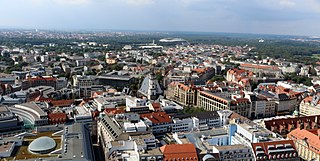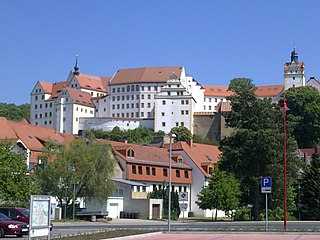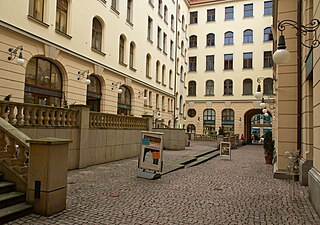
Leipzig is the most populous city in the German state of Saxony. The city has a population of 628,718 inhabitants as of 2023. It is the eighth-largest city in Germany and is part of the Central German Metropolitan Region. The name of the city is usually interpreted as a Slavic term meaning place of linden trees, in line with many other Slavic placenames in the region.

Colditz is a small town in the district of Leipzig, in Saxony, Germany. It is best known for Colditz Castle, the site of the Oflag IV-C POW camp for officers in World War II.

Naumburg is a town in the district Burgenlandkreis, in the state of Saxony-Anhalt, Central Germany. It has a population of around 33,000. The Naumburg Cathedral became a UNESCO World Heritage Site in 2018. This UNESCO designation recognizes the processes that shaped the European continent during the High Middle Ages between 1000 and 1300: Christianization, the so-called "Landesausbau" and the dynamics of cultural exchange and transfer characteristic for this very period.

Messe Frankfurt is the world's largest trade fair, congress and event organizer with its own exhibition grounds. The organization has 2,500 employees at some 30 locations, generating annual sales of around €661 million. Its services include renting exhibition grounds, trade fair construction and marketing, personnel and food services.
The Hanover Fairground is an exhibition area in the Mittelfeld district of Hanover, Germany. Featuring 392,453 m² of covered indoor space, 58,000 m² of open-air space, 24 halls and pavilions, and a convention center with 35 function rooms, it is the largest exhibition ground in the world.
Theodoric I, called the Oppressed, was the Margrave of Meissen from 1198 until his death. He was the second son of Otto II, Margrave of Meissen and Hedwig of Brandenburg.

The Städtisches Kaufhaus in Leipzig, designed by the municipal architects Rayher, Korber and Müller in the style of Baroque Revival architecture, was constructed from 1894 to 1901.

Taucha is a town in the district of Nordsachsen, in Saxony, Germany. It is situated on the river Parthe, 10 km northeast of Leipzig.

The Games Convention (GC), sometimes called the Leipzig Games Convention, was an annual video game event held in Leipzig, Germany, first held in 2002. Besides video games, the event also covers Infotainment, Hardware, and Edutainment. Its concept was created by the Leipziger Messe in cooperation with Bundesverband für Interaktive Unterhaltungssoftware amongst others. The 2010 Gamescon was held August 18 to August 22.

The Leipzig Book Fair is the second largest book fair in Germany after the Frankfurt Book Fair. The fair takes place annually over four days at the Leipzig Trade Fairground in the northern part of Leipzig, Saxony. It is the first large trade meeting of the year and as such it plays an important role in the market and is often where new publications are first presented.

Messe Freiburg is an event area and exhibition grounds in Freiburg im Breisgau.

Richard-Wagner-Platz is a square in Leipzig in the northwest of Leipzig city centre within Leipzig's "ring road" on the northwest corner. The square is named after the composer Richard Wagner, whose house of birth was nearby.

The Opernhaus vorm Salztor was an opera house in Naumburg, then Saxe-Zeitz, that opened in 1701. The house was built during the regency of Moritz Wilhelm, Duke of Saxe-Zeitz, on his behalf. In 1716, it burned down and was not rebuilt. In the 15 years of its existence, at least 14 different operas and one play were performed there. One of them survived, Johann David Heinichen's Der glückliche Liebeswechsel oder Paris und Helena, and was revived in 2012 in a concert performance.

The Alte Handelsbörse or Alte Börse in Leipzig, Saxony, Germany, is the city's oldest assembly building of merchants, and also the oldest Baroque building. Built as the Börse in 1678, it is now used as an event venue and is known in English as the Old Stock Exchange.

The history of the architecture of Leipzig extends from the Middle Ages to the 21st century. Numerous typical buildings and valuable cultural monuments from different eras are still preserved or have been rebuilt. Leipzig, Germany, begins its architectural history with several buildings in the Romanesque style. An example of Gothic architecture in Leipzig is the late Gothic hall vault of the Thomaskirche (1482/1496). In the early modern period, the Old Town Hall was expanded in the Renaissance style. The city experienced the peak of urban design and artistic development from around 1870 to 1914 with historicism, Reformarchitektur and Art Nouveau. Numerous trade fair palaces, commercial buildings, representative buildings such as the Imperial Court Building and the new town hall and the arcade galleries known for the city were built. After the First World War, Leipzig became known for its neoclassicism. During the air raids on Leipzig in World War II, large parts of the city center, which was rich in historic buildings, were destroyed. This was followed in the post-war period by (socialist) neoclassicism and modernism.

Alte Messe Leipzig is the circa 50 hectares site in the southeastern part of Leipzig's district Mitte, where from 1920 until 1991 the technical exhibitions of the Leipzig Trade Fair took place, as well as the buildings that stand on it – but not the trade fair itself, which found a new home at a new site in the northern part of Leipzig. Since 1996 there has been no trade fair activity on the old site.

Petersstrasse is one of the oldest streets in Leipzig's district of Mitte. For centuries it was a main and commercial street for the Leipzig trade fair with exhibition houses, inns and shops. In the second half of the 19th century, many of the old buildings on the street fell victim to the modernization of the city center. Today it is a heavily frequented pedestrian zone in a prime location with shopping centers, department stores, shops, restaurants and cinemas.

The Alte Waage, in English: Old Weigh House, is a building that stands on the north side of the Markt of the German city of Leipzig, on the corner with Katharinenstrasse. Originally, it was built in 1555 under the direction of the mayor and builder Hieronymus Lotter (1497–1580) and the executive master builder Paul Speck. It is an example of the Saxon Renaissance.

Specks Hof is a commercial building with the oldest preserved shopping arcade in Leipzig, Germany. The complex near St. Nicholas Church is an example of Leipzig's trade fair and trading buildings, which were built at the beginning of the 20th century.

The concept of the sample fair was invented in 1895 in Leipzig, Germany. At the Leipzig Trade Fair the traditional goods fair was replaced with sample shows. The sample fairs are the usual type of trade fair today, which is facing another paradigm shift due to the digital transformation, accelerated by the COVID-19 pandemic.




















